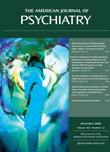In this Issue
Disrupted Rhythms
Disordered circadian and sleep rhythms are poorly understood features of mental disorders. Sleep problems reported by older adults with past depression portend recurrence of depression in the 2 years following sleep assessment. Cho et al. (CME, p. Original article: 1543 ) found this relationship to be independent of sociodemographic traits, medical conditions, other depressive symptoms, and antidepressant use. Recurrence was less likely in those without sleep disturbances, and sleep problems in subjects without past depression did not portend the onset of depression. Depressed pregnant women studied by Parry et al. (p. Original article: 1551 ) had basic disturbances in the biology of their circadian rhythms. They had lower morning melatonin concentrations than pregnant women without depression. Melatonin levels increased over the course of pregnancy in the healthy women but not in the women with depression. Conversely, in the year following childbirth, the depressed women had higher melatonin levels than the nondepressed women. Disturbances in circadian rhythms can be therapeutic targets. Frank et al. (CME, p. Original article: 1559 ) report faster improvement in occupational functioning among patients with bipolar disorder who received interpersonal and social rhythm therapy, which helps patients stabilize daily routines and sleep-wake cycles. This treatment was compared with a psychoeducational and supportive approach; all patients also received pharmacotherapy. The two groups had similar improvements over 2 years, but they differed at the end of 9 months of acute treatment. Dr. Ellen Leibenluft examines the role of biological rhythms in psychiatric disorders in an editorial on p. Original article: 1501 .

Understanding Risk and Resilience
Genetic variants and traumatic experiences are two possible risk factors for mental disorders. However, a wider range of outcomes often results from such risk factors. Alim et al. (CME, p. Original article: 1566 ) identified 259 people with trauma histories in a high-risk urban area. Psychiatric illness was not the inevitable result of trauma. Compared to those who were currently ill, resilient individuals who did not develop psychiatric disorders were more likely to report having a purpose in life. However, they had experienced fewer types of trauma, especially physical assaults. Those who had psychiatric histories but had recovered were also more likely to report having a purpose in life, as well as feelings of mastery. Paracchini et al. (p. Original article: 1576 ) pinpointed genetic factors in reading skills among the general population. A genetic haplotype found initially in dyslexia was more generally associated with poor reading and spelling performance among more than 6,000 children ages 7–9 from a general population cohort. In an editorial on p. Original article: 1505 , Dr. Robert Freedman discusses these articles as models of research on the spectrum of normal response to risk factors.
GABA Deficits and Their Treatment in Schizophrenia
Deficits in markers of γ-aminobutyric acid (GABA) neurotransmission are an emerging pathogenic feature of schizophrenia that has become a new target for experimental therapeutics. Performance on several cognitive tests improved in patients with chronic schizophrenia who received an experimental drug that enhances activity at a subset of receptors for GABA. The benzodiazepine-like agent tested by Lewis et al. (p. Original article: 1585 ) selectively activates GABA A receptors with α 2 subunits. In addition to improving more on the cognitive tests than patients taking placebo, those taking the new drug also had greater increases in frontal gamma-band EEG activity during a test of cognitive control. Bullock et al. (p. Original article: 1594 ) report altered expression of genes involved in GABA activity in the cerebellum of patients with schizophrenia. Post-mortem messenger RNA transcripts of several GABA markers and neuromodulators in the cerebellum were lower in patients than in comparison subjects. Higher levels of other transcripts suggest partial compensatory responses. The GABA neurotransmission deficits could contribute to disinhibited signaling and to symptoms associated with abnormal cerebellar function in schizophrenia. An editorial by Dr. Schahram Akbarian on p. Original article: 1507 examines GABA pathophysiology in schizophrenia.



